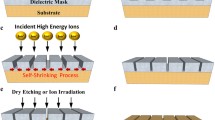Abstract
The display industries recently demand new microscale dot-type patterns for thinner and brighter displays with high energy efficiency, which are randomly distributed with irregular separation distances and have uniform optical characteristics. We developed a new program to generate the coordinates of the controlled microscale random patterns considering their diameter and the distance to the nearest pattern for preventing overlap of each pattern. Then the microscale random patterns were machined on a metal mold using the indentation machining which is a simple and low-cost machining method. We decreased the total machining time by the optimization of machining order of the random patterns. The coordinates, the diameter and the fill-factor of the machined patterns by the indentation machining were much consistent to the designed values. The controlled microscale random patterns had uniform optical characteristics over all areas of the manufactured optical film. Moreover, if optical films have the same diameters and fill-factor, they showed the same optical characteristics even they have totally different coordinates of random microscale patterns. This technology is expected to reduce the number of the optical films and the light sources in the display, which can save much energies.















Similar content being viewed by others
References
Zhou S, Cao B, Liu S, Ding H (2012) Improved light extraction efficiency of GaN-based LEDs with patterned sapphire substrate and patterned ITO. Opt Laser Technol 44:2302–2305
Pudis D, Suslik L, Skriniarova L, Kovac L, Kovac J (2013) Effect of 2D photonic structure patterned in the LED surface on emission properties. Appl Surf Sci 269:161–165
Jeong SM, Kissinger S, Kim DW, Lee SJ, Kim JS (2010) Characteristic enhancement of the blue LED chip by the growth and fabrication on patterned sapphire (0001) substrate. J Cryst Growth 312:258–262
Cho JY, Hong SH, Byeon KJ, Lee H (2012) Light extraction efficiency improvement in GaN based blue light emitting diode with two-dimensional nano-cavity structure. Thin Solid Films 521:115–118
Ee YK, Li XH, Biser J, Cao W, Chan HM (2010) Abbreviated MOVPE nucleation of IIIN itride light-emitting diodes on nano-patterned sapphire. J Cryst Growth 312:1311–1315
Li CJ, Fang YC, Chu WT, Cheng MC (2018) Design of a prism light-guide plate for an LCD backlight module. J Soc Inf Display 16(4):545–550
Li CJ, Fang YC, Cheng MC (2010) Prism-pattern design of an LCD guide plate using a neural-network optical model. Optik 121:2245–2249
Zhao WX, Wang QH, Wang AH, Li DH (2010) Autostereoscopic display based on two-layer lenticular lenses. Opt Lett 35:4127–4129
Funamoto A, Aoyama S (2003) LED backlight system with double-prism pattern. J Soc Inf Display 11(4):1045–1051
Idé T, Numata H, Taira Y, Mizuta H, Suzuki M, Noguchi M, Katsu Y (2003) A novel dot-pattern generation to improve luminance uniformity of LCD backlight. J Soc Inf Display 11(4):659–665
Mao X, Li H, Han Y, Luo Y (2014) A two-step design method for high compact rotationally symmetric optical system for LED surface light source. Opt Express 22:A233–A247
Fang F, Zhang X, Weckenmann A, Zhang G, Evans C (2013) Manufacturing and measurement of freeform optics. CIRP Ann Manuf Technol 62:823–846
Lee YM, Lee JH, Jeon E (2010) A study on an integrated light guide plate. J Opt Soc Korea 21:53–60
Shih CJ, Lin WC, Lin CS, Ou SF, Pan YN (2013) Fabrication of diamond conditioners by using a micro patterning and electroforming approach. Microelectron Eng 103:92–98
Lim CS, Hong MH, Kumar S, Rahman A, Liu M (2006) Fabrication of concave micro lens array using laser patterning and isotropic etching. Int J Mach Tools Manuf 46:552–558
Radtke D, Duparré J, Zeitner UD, Tünnermann A (2007) Laser lithographic fabrication and characterization of a spherical artificial compound eye. Opt Express 15:3067–3077
Nayak BK, Gupta MC (2010) Self-organized micro/nano structures in metal surfaces by ultrafast laser irradiation. Opt Laser Technol 48:940–949
Jeon E, Lee JR, Choi DH, Choi HJ, Je TJ (2017) A new application of dynamic indentation: indentation machining technology. Exp Mech. https://doi.org/10.1007/s11340-016-0187-5
Oh HS, Cho HR, Park H, Hong ST, Chun DM (2016) Study of electrically-assisted indentation for surface texturing. Int J Precis Eng Manuf Green Technol 3:161–165
Chaudhri MM, Winter M (1988) The load-bearing area of a hardness indentation. J Phys D Appl Phys 21:370–374
McElhaney KW, Vlassak JJ, Nix WD (1998) Determination of indenter tip geometry and indentation contact area for depth sensing indentation experiments. J Mater Res 13:1300–1306
Oliver WC, Pharr GM (2004) Measurement of hardness and elastic modulus by instrumented indentation: advances in understanding and refinements to methodology. J Mater Res 19:3–20
Cheng YT, Cheng CM (1998) Effects of ‘Sinking in’ and ‘Piling up’ on estimating the contact area under load in indentation. Philos Mag Lett 78:115–120
Lee JR, Jeon E, Kim HS, Woo W, Je TJ, Yoo YE, Lee ES (2015) Optical characterization and manufacturing of an optical plate for increasing light efficiency of LED systems. Int J Precis Eng Manuf 16:1355–1360
Acknowledgements
This work was supported by the 2018 Research Fund of University of Ulsan.
Author information
Authors and Affiliations
Corresponding authors
Additional information
Publisher's Note
Springer Nature remains neutral with regard to jurisdictional claims in published maps and institutional affiliations.
Rights and permissions
About this article
Cite this article
Lee, JR., Moon, S.H., Je, TJ. et al. Manufacture of microscale random pattern using indentation machining technology. Int. J. of Precis. Eng. and Manuf.-Green Tech. 7, 1047–1057 (2020). https://doi.org/10.1007/s40684-020-00240-4
Received:
Revised:
Accepted:
Published:
Issue Date:
DOI: https://doi.org/10.1007/s40684-020-00240-4




